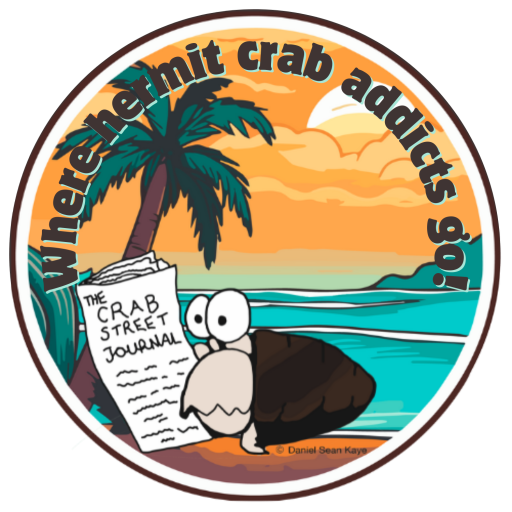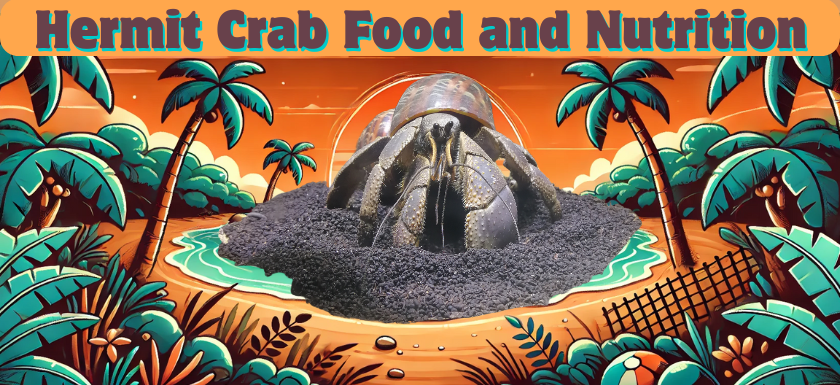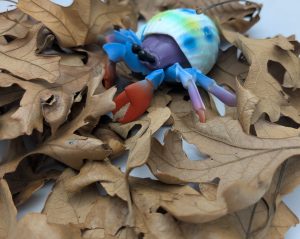Written by Vanessa Pike Russell 2004
I have done some research on colour enhancing foods and figuring out how to get crabs a certain colour.
If you want really dark brown colour hermit crabs then give them lots of foods rich in tannins such as Brown Oak Leaves, Brown Oak Bark (pesticide free). This comes from Carol of CrabWorks. Her hermit crabs have been eating this since they were itty bitty crabbies, 28+ years ago!
https://www.fs.fed.us/wildflowers/ethnobotany/tannins.shtml
If you want orange hues that foods such as carrots, marigold petals have been known to create an increase in orange colour. Foods rich in Astaxanthin are what you are looking for. Do some googling of Astaxanthin and crustacean color/colour.
Plus, I think I may have found a tiny piece of the puzzle as to the ‘blue’ Ecuadorian crabs that have been around.
“The lack of dietary astaxanthin in cultured Penaeus monodon has been shown to be the cause of “Blue Color Syndrome”. After four weeks of feeding a diet containing 50 ppm of astaxanthin, prawns with Blue Color Syndrome resume their normal greenish-brown pigmentation. Analysis of the tissues from the experimental groups verified that the astaxanthin-fed group increased in carotenoids 318% , and had a normal appearance. Those fed the commercial diet without astaxanthin had a carotenoid increase of only 14% and had a blue hue (Menasveta et al. 1993).”
I have heard from many friends in the USA who bought crabs of an unusual bluish hue, that when moulted changed to the standard colours. It was often thought that this was due to some food available in the wild, such as a blue flower of the Galapagos, but it may be that the blue is a sign of lack of dietary astaxanthin. It sounds probable to me! I have contacted some of my favourite biologists about my ponderings and I will be sure to post any information (with permission) to my journal.
For your experiment, it would help if you could take a photo under the same lighting conditions on a regular basis (eg. every week) and create journal entries which have been marked as memories ‘colour experiment’. That way it would be easy to keep track of the changes in exo colour and your observations.
Foods I would offer include:
- Spirulina
- Kelp
- Oak Leaves/Bark
- Raisins
Note – “Paprika contains the xanthophylls beta-carotene, beta-cryptoxanthin, capsanthin and capsorubin, some of which can apparently be slowly converted to astaxanthin after a lag time. (D’Abramo 1983, Latscha 1991, Wyban, 1996). Preliminary trials demonstrate that supplementation with NatuRose natural astaxanthin yields superior results compared to paprika, as there is no lag time for biosynthetic conversion and it can be directly utilized for metabolic purposes. NatuRose natural astaxanthin is now exclusively used in High Health broodstock to improve larval quality, survival and allow sustained nauplii production (Jim Wyban, personal communication).”
“The color of various carotenoids are related to the number of alternating double-bond pairs in the long polyene chain of the molecule, known as the chromophore (Figure 1). Specifically, light energy is absorbed by the carotenoid polyene system between 400-700 nm, and is converted into vibrational energy and heat, each carotenoid having a unique resonance in this regard. The carrot root contains predominantly (-carotene, which consists of 9 double-bond pairs within the polyene chain, and confers a yellow to orange color. The carotenoid, (-carotene, is composed of 10 alternating double-bond pairs and confers a deeper orange color, whereas the red color of ripe tomatoes and the flesh of watermelons is conferred by lycopene which consists of 11 alternating double-bonds in the polyene chain. Although the polyene structure of astaxanthin is composed of 9 double-bonds similar to (-carotene, the keto and hydroxyl groups of the terminal ring structures contribute to the perceived color through absorption resonance.”
I could go on and on, but I think this will help with the brainstorming process 🙂
What is Astaxanthin?
Astaxanthin is a red-orange pigment that occurs in the natural diets of many aquatic species, including salmon, trout, and shrimp. It is closely related to more commonly known carotenoids such as beta-carotene or lutein. It is referenced in the US Code of Federal Regulations Title 21 PART 73—LISTING OF COLOR ADDITIVES EXEMPT FROM CERTIFICATION—Subpart A-Foods (Sec. 73.35 Astaxanthin).
Where does Astaxanthin come from?
Astaxanthin isolated from crustacean wastes or produced synthetically. Astaxanthin can also be farmed from unicellular green alga called Haematococcus pluvialis or certain types of yeast and then prepared for commercial use.
Why is it used in commercial aquaculture?
Astaxanthin is added to the feed for salmon, trout, red seabream or shrimp to improve the pigmentation of the flesh or the skin. Salmon and other marine animals cannot make the compound themselves and must get it from their diets This use remains by far the largest market in terms of volume and market value.
Some research suggests that astaxanthin has a number of essential biological functions, ranging from protection against oxidation of essential polyunsaturated fatty acids, protection against UV-light effects, pro-vitamin A activity and vision, immune response, pigmentation, and improved reproduction. As a result, astaxanthin is now also used by some to enhance the immune response of fish and shrimp and to ensure maximum survival and growth.
Is Astaxanthin a safe additive?
It is classified by FDA in a category of color additives called “Exempt from Certification”. The general public often refers to these as “natural” because they are not synthetic organic dyes. Other commonly used “natural” (or “exempt from certification”) color additives include beta-carotene (e.g., carotenoids from sources such as carrots) and anthocyanins (red hued pigments from blueberries and cabbage). To be listed in this category, a color additive must be regarded as posing little or no threat to humans. Currently there is no record of adverse health effects in fish or people consuming astaxanthin.
Health concerns aside, USDA and FDA continue to monitor fish and seafood industry practices to make sure that astaxanthin is not used to pass off one fish species as another. For example, FDA has documented cases in which some disreputable suppliers were offering a fictional variety of salmon called “Salmon Trout” for a much higher price than regular trout. However, as a color enhancer in fish and seafood, the appropriate use of astaxanthin does not present any known health risk to consumers
http://www.wholefoods.com/healthinfo/astaxanthin.html
The lack of dietary astaxanthin in cultured Penaeus monodon has been shown to be the cause of “Blue Color Syndrome”. After four weeks of feeding a diet containing 50 ppm of astaxanthin, prawns with Blue Color Syndrome resume their normal greenish-brown pigmentation. Analysis of the tissues from the experimental groups verified that the astaxanthin-fed group increased in carotenoids 318% , and had a normal appearance. Those fed the commercial diet without astaxanthin had a carotenoid increase of only 14% and had a blue hue (Menasveta et al. 1993).
See also:
Beneficial Foods for Hermit Crabs Containing Zeaxanthin
Foods for Hermit Crabs Containing Carotenids
References
Brine Shrimp Directhttps://www.brineshrimpdirect.com/


